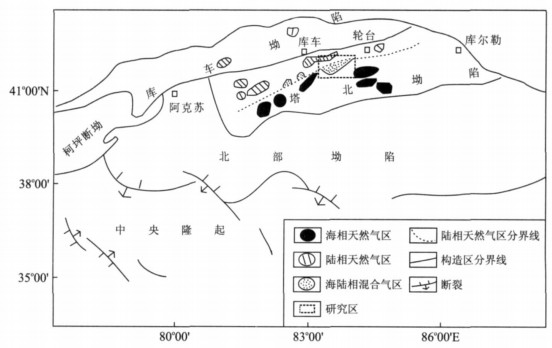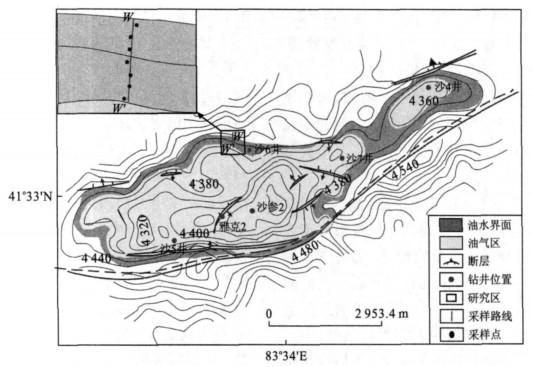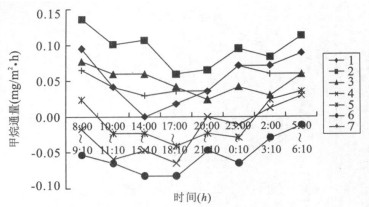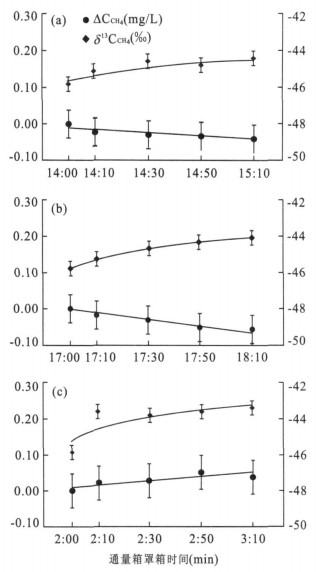Natural Emissions of Methane and Source Identification from Oil-Water Interface of Yakela Condensed Oil/Gas Field
-
摘要: 为评价油气田天然释放CH4对大气CH4源与汇的贡献, 采用静态箱法实地监测了新疆塔里木盆地雅克拉凝析油气田油水界面处甲烷的释放通量, 并采用在线大气甲烷碳同位素制样系统与稳定同位素质谱仪联机测试了通量箱甲烷碳同位素组成.结果表明, 由于油水界面边水活跃程度不同, 甲烷通量在空间变化很大, 最高的日释放通量达2.28 mg/m2·d, 最低-1.32 mg/m2·d, 日平均释放通量0.51 mg/m2·d, 标准偏差达1.23 mg/m2·d.油水界面处甲烷通量日变化规律基本相同, 凌晨至清晨时达到相对高点, 随后逐渐降低, 下午至傍晚时段为释放低值甚至负值, 夜晚时分又逐渐增加.通量箱中甲烷δ13C组成白天随甲烷浓度的线性降低而逐渐偏重, 夜晚δ13C随着甲烷浓度的线性增加而逐渐偏重.可见, 油水界面边水活跃, 其上方的土壤形成相对氧化的环境, 油气藏甲烷及烃类在向地表运移的过程中不断被土壤吸收氧化, 仅有少量运移至地表并逸散到大气中, 局部甚至均被吸收氧化, 而成为大气甲烷的汇.Abstract: In order to assess correctly the flux of CH 4 emitted naturally from oil/gas basin, a static flux chamber method was applied to study natural emissions of methane to the atmosphere in oil-water interface of Yakela condensed oil/gas field in Tarim basin, Xinjiang.Using an online method which couples a gas chromatography/high-temperature conversion/isotope ratio mass spectrometry (GC/C/MS) together, 13C/12C ratios of the methane in flux chambers were measured.The results demonstrate that oxidation environments of soil and water are different in the oil-water interface because chambers lie in different places.So, fluxes of methane emission in the chambers are very different.The maximum daily flux of methane emission is 2.28 mg/m2·d and the minimum-1.32 mg/m2·d.The average daily flux of methane emission is 0.51 mg/m2·d with the standard deviation of 1.23 mg/m2·d.Although there are large differences in flux of methane emission in the oil-water interface, daily change laws are similar: the methane emission flux reaches the maximum at 5:00-6:00 am, and then it decreases gradually, and reaches the minimum at 17:00-18:00 pm, and then it gradually increases.Measurement of carbon isotope of methane shows that δ13C of methane becomes heavier with decreasing concentration in the afternoon and with increasing concentration in the morning.Thus it can be seen that the soil above the oil-water interface becomes a more oxidation environment because water contains O2. Methane is absorbed and oxidated constantly during migration to the earth's surface from deep oil/gas reservoir through microseepage and pervasion.Only a little methane which is not oxidized and degraded is discharged into the atmosphere through diffusing and convection.Even all methane is absorbed by soil in some areas, which leads to the sink of atmospheric methane.
-
Key words:
- oil-water interface /
- methane emission /
- stable carbon isotope /
- flux chamber
-
图 1 塔里木盆地各类天然气藏分布示意图(据黄传波, 1999)
Fig. 1. Sketch showing distribution of natural gases in Tarim basin
表 1 油水界面区各通量箱不同时段甲烷排放/吸收通量(mg/m2·h)
Table 1. Flux of methane emission of every flux chamber in different times in interface of oil and water

-
Abrams, M. A., 2005. Significance of hydrocarbon seepage relative to petroleum generation and entrapment. Ma-rine and Petroleum Geology, 22 (4): 457-477. doi: 10.1016/j.marpetgeo.2004.08.003 Baciu, C., Etiope, G., Cuna, S., et al., 2008. Methane seep-age in an urban development area (Bacau, Romania): Origin, extent, and hazard. Geofluids, 8: 1-10. doi: 10.1111/j.1468-8123.2007.00207.x Barker, J. F., Fritz, P., 1981. Carbon isotope fractionation during microbial methane oxidation. Nature, 293: 289-291. doi: 10.1038/293289a0 Chilingar, G. V., Endres, B., 2005. Environmental hazards posed by the Los Angeles basin urban oilfields: An his-torical perspective of lessons learned. Environmental Geology, 47: 302-317. doi: 10.1007/s00254-004-1159-0 Denman, K. L., 2007. Couplings between changes in the cli-mate systemand biogeochemistry. In: Solomon, S., ed., Climate change2007: The physical science basis. Contri-bution of working group I to the fourth assessment re-port of the intergovernmental panel on climate change. Cambridge Univ. Press, Cambridge, U. K., 7: 499-587. Dlugokencky, E. J., Steele, L. P., Lang, P. M., et al., 1994. The growth rate and distribution of at mospheric meth-ane. J. Geophys. Res. , 99: 17021-17043. doi: 10.1029/94JD01245 Dlugokencky, E. J., 2003. Atmospheric methane levels off: Temporary pause or a new steady-state? Geophysical Research Letters, 30 (19): 51-54. EIA (Energy Information Administration), 2003. Emissions of greenhouse gases in the United States. In: Compari-son of global warming wotentials fromthe IPCC's sec-ond and third assessment reports. http://www.eia.doe.gov/oiaf/1605/ggrpt/global.html. Etiope, G., 2004. GEM—geologic emissions of methane, the missing source in the at mospheric methane budget. At-mospheric Environm. , 38 (19): 3099-3100. Etiope, G., 2008. Natural emissions of methane from geolog-ical seepage in Europe. Atmosph. Environment, doi: 10.1016/j.atmosenv.03.014. Etiope, G., Fridriksson, T., Italiano, F., et al., 2007b. Natu-ral emissions of methane from geothermal and volcanic sources in Europe. J. Volcanol. Geotherm. Res. , 165: 76-86, doi: 10.1016/j.jvolgeores.2007.04.014. Etiope, G., Klusman, R. W., 2002. Geologic emissions of methane to the at mosphere. Chemosphere, 49 (8): 777-789. doi: 10.1016/S0045-6535(02)00380-6 Etiope, G., Klusman, R. W., 2009. Microseepage indrylands: Flux andimplications inthe global at mospher-ic source/sink budget of methane. Global Planet. Change (in press). Etiope, G., Lassey, K. R., Klusman, R. W., et al., 2008. Re-appraisal of the fossil methane budget and related emis-sion from geologic sources. Geophysical Research Let-ters, 35, L09307, doi: 10.1029/2008GL033623. Etiope, G., Martinelli, G., Caracausi, A. F. I., 2007a. Meth-ane seeps and mud volcanoes in Italy: Gas origin, frac-tionation and emissionto the at mosphere. Geophys. Res. Lett. , 34, L14303, doi: 10.1029/2007GL030341. Etiope, G., Milkov, A. V., 2004. A new estimate of global methane flux from onshore and shallow submarine mud volcanoes to the at mosphere. Environ. Geol. , 46: 997-1002. doi: 10.1007/s00254-004-1085-1 Etiope, G., Papatheodorou, G., Christodoulou, P., et al., 2006. Methane and hydrogen sulfide seepage in the NW Peloponnesus petroliferous basin (Greece): Origin and geohazard. AAPG Bull. , 90 (5): 701-713. doi: 10.1306/11170505089 Hilkert, A. W., Douthitt, C. B., Schluter, H. J., 1999. Iso-tope ratio monitoring gas chromatography/mass spec-trometry of D/H by high temperature conversion iso-tope ratio mass spectrometry. Rapid Communications in Mass Spectrometry, 13 (13): 1226-1230. doi: 10.1002/(SICI)1097-0231(19990715)13:13<1226::AID-RCM575>3.0.CO;2-9 Huang, C. B., 1999. Chracteristics of the condensate gasres-ervoirs in the North Art of Talimu basin and a discus-sion on their formation mechanism. Natural Gas Indus-try, 19 (2): 28-33 (in Chinese with English abstract). Hou, W. G., Su, J. Y., 2001. The evidence and characteristics of vertical micro-migration of upper pool's hydrocarbons in northern Tarim basin. Xinjiang Petroleum Geology, 22 (6): 465-470 (in Chinese with English abstract). IPCC, 2003. Comparison of global warming wotentials fromthe IPCC's second and third assessment reports. Ener-gy information administration. Emissions of GreenhouseGases in the United States, U. S. A. . Judd, A. G., 2004. Natural seabed seeps as sources of atmos-pheric methane. Environ. Geol. , 46: 988-996. doi: 10.1007/s00254-004-1083-3 Klusman, R. W., Jakel, M. E., 1998. Natural microseepage of methane to the at mosphere fromthe Denver-Julesburg basin, Colorado, USA. J. Geophys. Res. , 103 (D21): 28042-28045. Klusman, R. W., Jakel, M. E., LeRoy, M. P., 1998. Does mi-croseepage of methane and light hydrocarbons contrib-ute to the at mospheric budget of methane and to global climate change? Assoc. Pet. Geochem. Explor. Bull. , 11: 1-55. Klusman, R. W., Leopold, M. E., LeRoy, M. P., 2000. Sea-sonal variation in methane fluxes fromsedimentary ba-sins to the at mosphere: Results fromchamber measure-ments and modeling of transport from deep sources. J. Geophys. Res, 105: 24661-24670. doi: 10.1029/2000JD900407 Klusman, R. W., 2003a. Rate measurements and detection of gas microseepage to the at mosphere from an enhanced oil recovery/sequestration project, Rangely, Colorado, USA. Applied Geochemistry, 18 (12): 1825-1838. doi: 10.1016/S0883-2927(03)00108-2 Klusman, R. W., 2003b. A geochemical perspective and as-sessment of leakage potential for a mature carbon dioixide-enhanced oil recovery project and as a proto-type for carbon dioxide sequestration: Rangely field, Colorado. Amer. Assoc. Petrol. Geol. Bull. , 87: 1485-1507. Klusman, R. W., 2006. Detailed compositional analysis of gas seepage at the National Carbon Storage Test Site, Tea-pot Dome, Wyoming, USA. Applied Geochemistry, 21: 1498-1521. doi: 10.1016/j.apgeochem.2006.06.009 Keita, Y., Yoko, O., Fumiko, N., et al., 2003. An improved method for measurement of the hydrogen isotope ratio of at mospheric methane andits applicationto a Japanese urban at mosphere. Atmospheric Environment, 37: 1975-1982. doi: 10.1016/S1352-2310(03)00030-X Lassey, K. R., Lowe, D. C., Smith, A. M., 2007. The at mos-pheric cycling of radiomethane and the "fossil fraction" of the methane source. Atmos. Chem. Phys. , 7: 2141-2149. doi: 10.5194/acp-7-2141-2007 Lelieveld, J., Crutzen, P. J., Dentener, F. J., 1998. Changing concentration, lifetime and climate forcing of at mos-pheric methane. Tellus. (Ser. B), 50: 128-150. doi: 10.3402/tellusb.v50i2.16030 Li, N. H., Li, G. R., Tan, W. B., 1991. Petroleumgeology study in northern Tarim basin, China (Ⅰ). China University of Geosciences Press, Wuhan, 239-246 (in Chinese). Liu, F. J., Wu, G. P., Guo, Y., et al., 2008. Extraction of oil and gas haloes based on ETM+data: A case study from Yakela, Xinjiang. Earth Science—Journal of Chi-na University of Geoscienes, 33 (1): 106-111 (in Chi-nese with English abstract). Michael, J. W., 1990. A geochemical perspective of natural gas and at mospheric methane. Organic Geochemics, 16 (1-3), 531-547. doi: 10.1016/0146-6380(90)90068-B Mosier, A. R., Parton, D. W., Valentine, D. S., 1991. Meth-ane and nitrous oxide fluxes in native, fertilized and cul-tivated grasslands. Nature, 350: 330-332. doi: 10.1038/350330a0 Nesbit, S. P., Breitenbeck, G. A., 1992. A laboratory study of factors influencing methane uptake by soils. Agri. Ecos. Environ. , 41 (1): 39-54. doi: 10.1016/0167-8809(92)90178-E Qian, M. Y., 1998. Evidence of vertical hydrocarbon mi-cromigrationin geochemical section of artesian well. In: Cheng, T. J., Wang, Z. S., Wu, X. M., et al., eds. Thefouth collect of oil/gas geochemical prospect confer-ence. China University of Geosciences Press, Wuhan, 37-40 (in Chinese). Rice, A. L., 2001. Highprecision continuous—Flow measure-ment of δ13C and δD of at mospheric CH4. Analytical Chemistry, 73: 4104-4110. doi: 10.1021/ac0155106 Rust, F., 1981. Ruminant methane delta (13C/12C) values: Relation to at mospheric methane. Science, 211: 1044-1046. doi: 10.1126/science.7466376 Stevens, C. M., Rust, F. E., 1982. The carbon isotopic com-position of at mospheric methane. Journal of Geophys-ics Research, 87 (C7): 4879-4882. doi: 10.1029/JC087iC07p04879 Stevens, C. M., Engelkemeir, A., 1988. Stable carbon isotop-ic composition of methane from some natural and an-thropogenic sources. Journal of Geophysics Research, 93: 725-733. doi: 10.1029/JD093iD01p00725 Song, Y., Dai, J. X., Li, X. Q., Hong, F., 1998. Petroleum exploration main characteristics of geochemistry and Ggeology in China's mediumlarge gas fields. Acta Pe-trolei Sinica, 19 (1): 1-5 (in Chinese with English ab-stract). Tang, J. H., Bao, Z. Y., Xiang, W., et al., 2006. On-linemethod for measurement of the carbon isotope ratio of atmospheric methane and its application to at mosphere of Yakela condensed gas field. Environmental Science, 27 (1): 14-17 (in Chinese with English abstract). Tang, J. H., Bao, Z. Y., Xiang, W., et al., 2007. Daily varia-tion of natural emission of methane to the at mosphere and source identification in the Luntai fault region of the Yakela condensed oil/gas field in the Tarim basin, Xinjiang, China. Acta Geologica Sinica, 81 (5): 771-778. doi: 10.1111/j.1755-6724.2007.tb01001.x Tang, J. H., Bao, Z. Y., Xiang, W., et al., 2008. Geological emission of methane fromthe Yakela condensed oil/gas field in Tarim basin, Xinjiang, China. Journal of Envi-ronmental Sciences, 20 (9): 1055-1062. doi: 10.1016/S1001-0742(08)62149-X Tyler, S. C., Zimmerman, P. R., Cumberbatch, C., 1988. Measurements and interpretation of delat 13C of meth-ane fromtermites, rice paddies and wetlands in Kenya. Global Biogeochemical Cycles, 2 (4): 349-355. Tang, Y. P., Liu, Y. L., 2002. Study on the geochemical effects of vertical hydrocarbon micromigration and their mechanism. Experimental Petroleum Geology, 24 (5): 431-436 (in Chinese with English abstract). USGS National Oil and Gas Resource Assessment Team, 1995.1995 National assessment of United States oil and gas resources: U. S. geological survey digital data series DDS-30. http://energy.cr.usgs.gov/oilgas/noga/. Wahlen, M., Tanaka, N., Henry, R., 1989. Carbon-14 in methane sources and in at mospheric methane: The con-tribution fromfossil carbon. Science, 245: 286-290. doi: 10.1126/science.245.4915.286 Wang, Y. F., Ji, B. M., Chen, Z. Z., 2000. Preliminary results of a study on CH4 fluxin Xilin River basin steppe under different grazing intensities. Acta Phytoecol. Sin. , 24 (6): 693-696. Wuebbles, D. J., Hayhoe, K., 2002. Atmospheric methane and global change. Earth-Science Reviews, 57177-210. Zhang, B. L., Zhu, H. P., Wang, R. Y., 1998. Vertical micro-migration characteristics of deep hydrocarbon gas in the north Part of Talimu basin. Natual Gas Industry, 18 (1): 25-28 (in Chinese with English abstract). Zhang, N., Chen, S., Chen, J. L., 2001. Analysis on change trend of ratio of gas/oil of Cretaceous in Yakela conden-sate gas reservoir. Xinjiang Geology, 19 (1): 40-41 (in Chinese with English abstract). Zhong, G. F., Liu, X. F., Deng, C. N., et al., 2006. Middle-Upper Ordovician seismic sequences and submarine fan deposits in West Tadong Uplift, Tarim basin, North-west China. Earth Science—Journal of China Univer-sity of Geoscienes, 31 (3): 367-371 (in Chinese with English abstract). 侯卫国, 苏江玉, 2001. 塔北地区油气藏上方烃类垂向微运移的证据和特征. 新疆石油地质, 22 (6): 465-470. doi: 10.3969/j.issn.1001-3873.2001.06.004 黄传波, 1999. 塔里木盆地北部凝析气藏特征及成藏机制探讨. 天然气工业, 19 (2): 28-32. https://www.cnki.com.cn/Article/CJFDTOTAL-TRQG902.006.htm 李南豪, 李国蓉, 谭文斌, 1991. 中国塔里木盆地北部油气地质研究(Ⅰ). 武汉: 中国地质大学出版社, 239-246. 刘福江, 吴国平, 郭艳, 等, 2008. 基于ETM+遥感影像油气晕反演: 以新疆雅克拉地区为例. 地球科学——中国地质大学学报, 33 (1): 106-111. https://www.cnki.com.cn/Article/CJFDTOTAL-DQKX200801017.htm 钱铭云, 1998. 钻井地化剖面上烃气垂向微运移的迹象. 见: 程同锦, 王者顺, 吴学明, 等. 第四届全国油气化探学术会议论文集. 武汉: 中国地质大学出版社, 37-40. 宋岩, 戴金星, 李先奇, 等, 1998. 中国大中型气田主要地球化学和地质特征. 石油学报, 19 (1): 1-5. https://www.cnki.com.cn/Article/CJFDTOTAL-SYXB801.000.htm 汤玉平, 刘运黎, 2002. 烃类垂向微运移的地球化学效应及其机理讨论. 石油实验地质, 24 (5): 431-436. doi: 10.3969/j.issn.1001-6112.2002.05.009 唐俊红, 鲍征宇, 向武, 等, 2006. 大气甲烷碳同位素测试方法及其在雅克拉凝析气田上方大气中的应用. 环境科学, 27 (1): 14-17. https://www.cnki.com.cn/Article/CJFDTOTAL-HJKZ200601003.htm 张百灵, 朱怀平, 王汝勇, 1998. 塔里木盆地北部深层烃气垂向微运移特征. 天然气工业, 18 (1): 25-28. https://www.cnki.com.cn/Article/CJFDTOTAL-TRQG801.005.htm 张宁, 陈珊, 陈君莉, 2001. 雅克拉白垩系凝析气藏气油比变化趋势分析. 新疆地质, 19 (1): 40-41. https://www.cnki.com.cn/Article/CJFDTOTAL-XJDI200101021.htm 钟广法, 刘学锋, 邓常念, 等, 2006. 塔里木盆地塔东凸起西部中上奥陶统地震层序与海底扇沉积. 地球科学——中国地质大学学报, 31 (3): 367-371. https://www.cnki.com.cn/Article/CJFDTOTAL-DQKX200603012.htm -










 下载:
下载:




